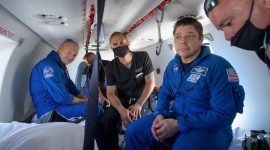8 Thrilling Martian Postcards to Celebrate NASA Curiosity Mars Rovers Anniversary
NASA‘s Curiosity Mars rover has seen a lot since August 5, 2012, when it first set its wheels inside the 96-mile-wide basin of Gale Crater. A Martian dust storm has actually minimized sunshine and visibility at the rover’s location in Gale Crater. Its mission is to study whether Mars had the water, chemical foundation, and energy sources that might have supported microbial life billions of years earlier.
The Curiosity mission is led by NASA’s Jet Propulsion Laboratory, which is managed by Caltech in Pasadena, California, and includes almost 500 researchers from the United States and other countries around the globe. The NASA rover touched down eight years ago, on August 5, 2012, and will soon be joined by a second rover, Perseverance. Curiosity has since travelled more than 14 miles, drilling 26 rock samples, and scooping 6 soil samples along the way as it exposed that ancient Mars was indeed appropriate for life.
Studying the textures and compositions of ancient rock strata is helping scientists piece together how the Martian climate changed with time, losing its lakes and streams until it ended up being the cold desert it is today. Curiosity will never venture to the upper portion of the mountain. Instead, it is checking out the many layers found lower down.
Each has a various story to outline how Mars, which was once more like Earth, altered over time.
The rover it will reach the next layer later this year. The crater rim and flooring where Curiosity began at eight years ago peek in from the left, while expanded is the future as Curiosity climbs higher on the mountain. Parts of the Martian desert resemble the American Southwest. Curiosity sometimes research clouds to find out more about the Martian environment.
There is vanishingly little water in the Martian air, which is 1% as thick as Earth’s air, but water-ice clouds do often form. New research study released in Nature Geoscience recommends hurrying rivers were not accountable for the unique shape of certain Martian valleys situated in the planet’s southern highlands. Rather, these geological functions were created by melting water rushing beneath enormous glaciers, in a geological procedure referred to as subglacial disintegration.
Ancient Mars, the new research study suggests, was most likely cold and icy, and not the temperate damp planet it is frequently presumed to be. The new research study challenges the commonly held view that the majority of valley networks on Mars were formed by rivers fed by precipitation. While the scientists found proof consistent with a small handful of valley networks having actually formed in this way, their observations recommend that the majority formed underneath ice sheets.
Ice sheets, and not hurrying rivers, sculpted many Martian valleys.
The new research study suggests ancient Mars was not as warm and wet as we thought. Remarkably, these outcomes, while surprising, appear to match the results from climate designs. Computer system simulations of ancient Mars recommend the Red Planet was cold and covered with ice some 3.8 billion years ago. The new research study analyzed satellite photos of 10,276 private valleys found in 66 valley networks on Mars, which the scientists did utilizing customized software application.
Ancient Mars was damp, but the brand-new paper complicates our understanding of this planet’s past by showing how erosional processes other than free-flowing surface water can sculpt particular geological functions. The scientists’ algorithm was able to match surface functions to specific erosional processes, consisting of glacial, subglacial, fluvial (surface water), and sapping (ground water) erosion. Of the 66 valley systems studied, the scientists recognized 22 as being formed from subglacial disintegration: 14 fluvial, nine glacial, 3 sapping, and 18 indeterminate.
These findings are the very first proof for substantial subglacial erosion driven by channelized meltwater drainage beneath an ancient ice sheet on Mars. Including that these results show that only a fraction of valley networks match patterns normal of surface water erosion, which is in marked contrast to the traditional view. The new analysis is intriguing but not conclusive.
The issue is that it is Mars and people have some pretty strong concepts about Mars and sometimes that gets in the way of the scientists looking at the observations.
This is one of those studies that makes scientists stop and ask themselves why did they assume that all the valley networks on Mars were fluvial? The environment models tell us that Mars was cold and icy so these scientists asked an extremely logical question, what kind of valley networks do we see? With the exception of the low number for sapping disintegration, this appears constant with a random circulation between the other processes.
That is, despite the fact that subglacial erosion is the most popular, it is not so dominant as to validate a conclusion that they are the major procedure. Fluvial and subglacial control, however, look more approximately equal among all processes.The scientists’ conclusions must have been that all of the processes that they examined played a function, and they have to search for a climate/environment that might support all of them.
If you take a look at Earth from a satellite, you see a great deal of valleys.Some of them made by rivers, some made by glaciers, some made by other processes, and each type has a distinctive shape. Mars is comparable, in that valleys look very different from each other, suggesting that many procedures were at play to sculpt them. Martian valleys were likewise compared to known subglacial features in the world.
It is becoming increasingly clear, however, that ancient Mars was a complex and vibrant place.
Devon Island, situated in the Canadian Arctic, is among the very best analogues we have for Mars here on Earth, as it is a cold, dry polar desert and we understand the glaciation is largely cold-based. Based on the scientists’ figures, there appears to be a smooth gradation between the residential or commercial properties of the specific valley networks. Certainly, the new information has to be fixed up with other geological evidence from ancient Mars, such as the webs of former lakes and river deltas (including Jezero crater, the destination site for the Mars Perseverance rover), clay formations (as discovered by the Curiosity rover), and even evidence of an ancient mega-tsunami on Mars.
Moving on, planetary researchers would do well to keep in mind this paper, even if it is somewhat insufficient.

